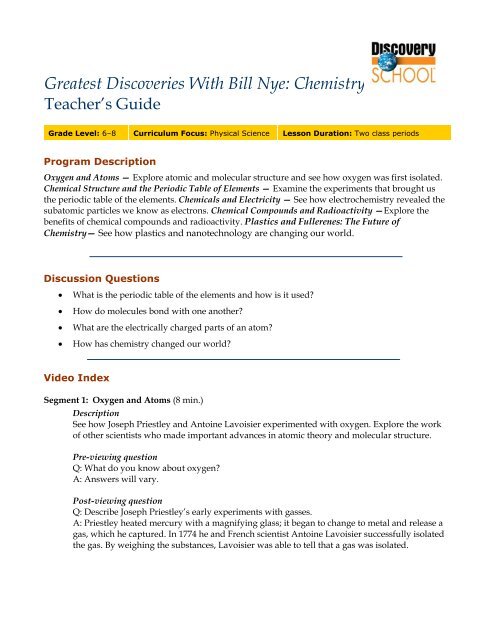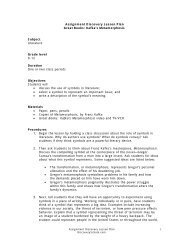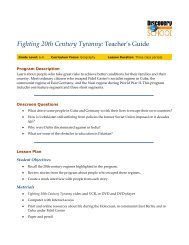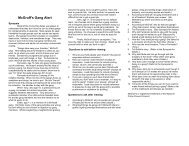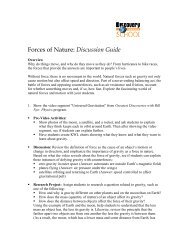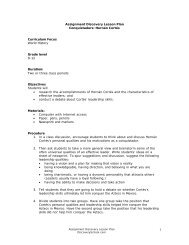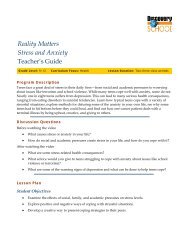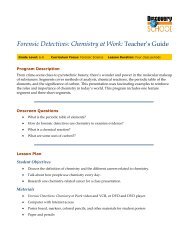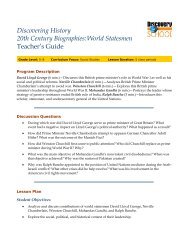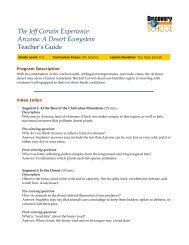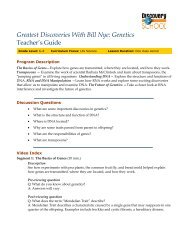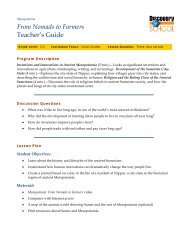Greatest Discoveries With Bill Nye: Chemistry - Free Teacher ...
Greatest Discoveries With Bill Nye: Chemistry - Free Teacher ...
Greatest Discoveries With Bill Nye: Chemistry - Free Teacher ...
Create successful ePaper yourself
Turn your PDF publications into a flip-book with our unique Google optimized e-Paper software.
<strong>Greatest</strong> <strong>Discoveries</strong> <strong>With</strong> <strong>Bill</strong> <strong>Nye</strong>: <strong>Chemistry</strong><br />
<strong>Teacher</strong>’s Guide<br />
Grade Level: 6–8 Curriculum Focus: Physical Science Lesson Duration: Two class periods<br />
Program Description<br />
Oxygen and Atoms — Explore atomic and molecular structure and see how oxygen was first isolated.<br />
Chemical Structure and the Periodic Table of Elements — Examine the experiments that brought us<br />
the periodic table of the elements. Chemicals and Electricity — See how electrochemistry revealed the<br />
subatomic particles we know as electrons. Chemical Compounds and Radioactivity —Explore the<br />
benefits of chemical compounds and radioactivity. Plastics and Fullerenes: The Future of<br />
<strong>Chemistry</strong>— See how plastics and nanotechnology are changing our world.<br />
Discussion Questions<br />
• What is the periodic table of the elements and how is it used?<br />
• How do molecules bond with one another?<br />
• What are the electrically charged parts of an atom?<br />
• How has chemistry changed our world?<br />
Video Index<br />
Segment 1: Oxygen and Atoms (8 min.)<br />
Description<br />
See how Joseph Priestley and Antoine Lavoisier experimented with oxygen. Explore the work<br />
of other scientists who made important advances in atomic theory and molecular structure.<br />
Pre-viewing question<br />
Q: What do you know about oxygen?<br />
A: Answers will vary.<br />
Post-viewing question<br />
Q: Describe Joseph Priestley’s early experiments with gasses.<br />
A: Priestley heated mercury with a magnifying glass; it began to change to metal and release a<br />
gas, which he captured. In 1774 he and French scientist Antoine Lavoisier successfully isolated<br />
the gas. By weighing the substances, Lavoisier was able to tell that a gas was isolated.
<strong>Greatest</strong> <strong>Discoveries</strong> <strong>With</strong> <strong>Bill</strong> <strong>Nye</strong>: <strong>Chemistry</strong><br />
<strong>Teacher</strong>’s Guide 2<br />
Segment 2: Chemical Structure (9 min.)<br />
Description<br />
Take a closer look at the experiments that led to the creation of the periodic table of the<br />
elements and learn how chemical bonds occur.<br />
Pre-viewing question<br />
Q: What chemical reactions you have observed?<br />
A: Answers will vary.<br />
Post-viewing question<br />
Q: How did August Kekule’s discovery about carbon change the science of chemistry?<br />
A: August Kekule established a simple formula to represent how chemicals bonded. Benzene<br />
was the only chemical compound that did not fit the formula because its chain of carbon and<br />
hydrogen atoms required more combining power than the formula allowed. Kekule realized<br />
that its six carbon atoms formed a ring (not a chain), and each one had a hydrogen atom<br />
attached with alternating single and double bonds. Thanks to this discovery, chemists had a<br />
formula to explain how carbon combined with other molecules to form chemical compounds.<br />
Segment 3: Chemicals and Electricity (8 min.)<br />
Description<br />
Electrochemistry helped scientists discover new elements and the electrically charged<br />
subatomic particles now known as electrons. Examine the contributions Humphry Davy, Robert<br />
Bunsen, and Joseph Thomson made to chemistry.<br />
Pre-viewing question<br />
Q: How can you tell which chemical elements are present in a burning substance?<br />
A: The color of a flame indicates which elements are present. Shades of yellow indicate sodium,<br />
and green indicates copper.<br />
Post-viewing question<br />
Q: How did Joseph Thomson discover electrons?<br />
A: Experimenting with the electrical part of atoms, Thomson hooked the ends of a glass tube to<br />
electrical sources, which created a stream of cathode rays. After exposing the stream of cathode<br />
rays to a magnet, it bent. Magnets can only affect matter, so he determined that the stream was<br />
composed of an electrically charged substance (radiant matter). Thomson had found the first<br />
subatomic particles: The ray was a stream of electrons.<br />
Segment 4: Chemical Compounds and Radioactivity (6 min.)<br />
Description<br />
Thanks in part to Marie Curie’s work we can understand the benefits and dangers of<br />
radioactivity. Explore the uses of chemical compounds and radioactivity in modern society.<br />
Pre-viewing question<br />
Q: Can you name some chemical compounds?<br />
A: Answers will vary.<br />
Published by Discovery Education. © 2005. All rights reserved.
<strong>Greatest</strong> <strong>Discoveries</strong> <strong>With</strong> <strong>Bill</strong> <strong>Nye</strong>: <strong>Chemistry</strong><br />
<strong>Teacher</strong>’s Guide 3<br />
Post-viewing question<br />
Q: What are the benefits of radioactivity?<br />
A: The benefits of radioactivity include medical imaging, which is used to help find tumors;<br />
calculating the age of the Earth; powering spacecraft; and creating steady electrical current in<br />
some smoke alarms.<br />
Segment 5: Plastics and Fullerenes (10 min.)<br />
Description<br />
Many plastic products are better and stronger than anything found in nature. Investigate<br />
nanotechnology, the future of chemistry, which is promising to produce even better artificial<br />
materials.<br />
Pre-viewing question<br />
Q: What would the world be like without plastics?<br />
A: Answers will vary.<br />
Post-viewing question<br />
Q: How do you think nanotechnology will change our world?<br />
A: Answers will vary.<br />
Lesson Plan<br />
Student Objectives<br />
• Investigate the history and future of chemistry.<br />
• Demonstrate an understanding of the importance of careful observation and experimentation.<br />
• Experiment, observe, and record the properties of different chemical mixtures.<br />
Materials<br />
• <strong>Greatest</strong> <strong>Discoveries</strong> <strong>With</strong> <strong>Bill</strong> <strong>Nye</strong>: <strong>Chemistry</strong> program<br />
• Cornstarch, about 2 ½ cups per student group<br />
• Food coloring, approximately six to eight drops per student group<br />
• Plastic baggies, two per student<br />
• Plastic bowls or plates, two per student group<br />
• Small paper cup, one per student group<br />
• Coffee stir sticks (tongue depressors or Popsicle sticks), two per student group<br />
• Water<br />
• Wax paper<br />
• White glue, about one cup per student group<br />
Published by Discovery Education. © 2005. All rights reserved.
<strong>Greatest</strong> <strong>Discoveries</strong> <strong>With</strong> <strong>Bill</strong> <strong>Nye</strong>: <strong>Chemistry</strong><br />
<strong>Teacher</strong>’s Guide 4<br />
• Borax solution (1 heaping teaspoon of Borax powder per cup of warm water; about 1 gallon for<br />
50 students)<br />
• Small scoop or dipper for the Borax solution<br />
• Metric rulers, one per student group<br />
• Measuring cup or 8-oz. beaker with milliliters marked, one per student group<br />
• Science journals or paper<br />
• Pencils and erasers<br />
• Computer with Internet access (optional)<br />
Procedures<br />
1. Use <strong>Greatest</strong> <strong>Discoveries</strong> <strong>With</strong> <strong>Bill</strong> <strong>Nye</strong>: <strong>Chemistry</strong> to explore the history and importance of<br />
chemistry. Once you have watched the program, talk about the periodic table of the elements<br />
and the important discoveries shown in the program. What do we know about the elements<br />
now? How do elements bond? What is a chemical compound? What is a polymer? What are the<br />
uses of plastics? Why are plastics important? What are some compounds and mixtures used in<br />
daily life?<br />
2. Talk about the importance of experimentation in science. Where would chemistry be without<br />
the discoveries and inventions featured? What might have happened if the chemists highlighted<br />
in the program had not carefully observed and recorded their experiments? Tell students they<br />
are going to conduct their own chemistry experiments to create two brand new substances. Like<br />
the chemists that have come before them, tell students that they will need to carefully record the<br />
steps they take to create their substances as well as their observations about the properties of<br />
the substances as they work with them. And finally, when they are satisfied with their products,<br />
they will need to brainstorm a name for their new mixtures and uses for these substances.<br />
3. Divide the class into pairs or groups of three. Before beginning the experiments, remind<br />
students to never eat or taste any substances in science class unless they are directed to do so by<br />
a teacher.<br />
4. First have students make “oobleck.” Remind them that this is just a working name and that<br />
once their product is finished they will need a new name for it. Give each student group the<br />
following:<br />
• 2 ½ cups cornstarch<br />
• 2 cups water<br />
• food coloring<br />
• wax paper<br />
• plastic bowl<br />
• stirrers<br />
• plastic baggies<br />
Published by Discovery Education. © 2005. All rights reserved.
<strong>Greatest</strong> <strong>Discoveries</strong> <strong>With</strong> <strong>Bill</strong> <strong>Nye</strong>: <strong>Chemistry</strong><br />
<strong>Teacher</strong>’s Guide 5<br />
5. Instruct students to put the cornstarch in the bowl and add about one cup of water, mixing with<br />
a stirrer as they pour. Each time they add a new ingredient to their mixture, have them stop and<br />
observe the changes in properties. What does the mixture look like? How does it feel? How<br />
does it smell? Tell them to record their actions and observations in their science journals or on<br />
a piece of paper.<br />
6. Have students add more water slowly if the mixture seems too dry and won’t stick together. It<br />
should not be too dry, but too much water could make it too runny. Students may pour the<br />
mixture onto the wax paper and mix it with their fingers if they are having trouble mixing it in<br />
the bowl.<br />
7. Tell students to add food coloring to their mixture. Once they are satisfied with the substance,<br />
have them put it on the wax paper (if it is not already there) and play with it. Have them<br />
discuss their substance with their lab partners. What does it look like? How does it feel? Can it<br />
stretch, bounce, or move in any other way? How can it be used? Give students time to observe<br />
the properties of their new substance. Once they have thought of a name and uses for it, ask<br />
them to divide it into the plastic baggies (one for each student) and set it aside. Make sure the<br />
groups have recorded the name and uses of their new substance.<br />
8. Next have students make “ectoplasmic residue.” Give student groups the following materials:<br />
• white glue<br />
• food coloring<br />
• water<br />
• stirrers<br />
• plastic bowl<br />
• small paper cup<br />
• wax paper<br />
• measuring cup or beaker<br />
• metric ruler<br />
9. Have students use their metric ruler to measure two centimeters up from the bottom of the<br />
small paper cup. Have them make a line on the inside and outside of the cup, clearly marking<br />
two centimeters. Next, have them fill the cup to the line with white glue and then pour the<br />
white glue into their mixing bowl.<br />
10. Have students measure out 14 ml. of water and add that to the glue, stirring well and<br />
observing and recording any changes. Then have them add 16 ml. of the Borax solution, stirring<br />
well and observing and recording any changes.<br />
11. The residue should be forming a slimy blob, but if it’s too runny, students may add a few more<br />
drops of the Borax solution. If it is too sticky, they may add a little more water. Once they have<br />
a blob that’s not too runny or sticky, have them add food coloring and put it on the wax paper.<br />
What does it look like? How does it feel? What happens when it’s pounded with a fist? Does it<br />
break apart easily? How is it similar to or different from the first substance? Have students<br />
Published by Discovery Education. © 2005. All rights reserved.
<strong>Greatest</strong> <strong>Discoveries</strong> <strong>With</strong> <strong>Bill</strong> <strong>Nye</strong>: <strong>Chemistry</strong><br />
<strong>Teacher</strong>’s Guide 6<br />
record their observations about this substance and compare it to the first one. Next, have them<br />
name this product and devise uses for it. They will divide it into two bags and take it home.<br />
12. When the investigations are complete, give students time to sell their new substances to the rest<br />
of the class. Give each group a several minutes to talk about their product and how it could be<br />
used.<br />
13. If time allows, have students go online and learn more about chemistry, compounds, and<br />
mixtures from the following Web sites:<br />
Assessment<br />
• http://library.thinkquest.org/3659/<br />
• http://www.mcps.org/bhs/classes/dana/Matter.html<br />
• http://www.webelements.com/index.html<br />
Use the following three-point rubric to evaluate students’ work during this lesson.<br />
Vocabulary<br />
• 3 points: Students were highly engaged in class discussions; were highly focused and<br />
engaged during the investigations; enthusiastically participated in successful lab<br />
experiments and presentations; made careful observations of their experiments; and<br />
demonstrated a solid understanding of the importance of experimentation and observation<br />
in chemistry.<br />
• 2 points: Students were engaged in class discussions; were focused and engaged during the<br />
investigations; participated in somewhat successful lab experiments and presentations;<br />
made good observations of their experiments; and demonstrated a basic understanding of<br />
the importance of experimentation and observation in chemistry.<br />
• 1 point: Students participated minimally in class discussions; were unfocused and not<br />
engaged during the investigations; minimally participated in lab experiments and<br />
presentations; made incoherent or incomplete observations of their experiments; and were<br />
unable to demonstrate an understanding of the importance of experimentation and<br />
observation in chemistry.<br />
chemistry<br />
Definition: The science of the composition, structure, properties, and reactions of matter,<br />
especially of atomic and molecular systems<br />
Context: The science of chemistry has yielded great discoveries that are useful and helpful to<br />
humankind.<br />
compound<br />
Definition: A pure substance composed of more than one element<br />
Published by Discovery Education. © 2005. All rights reserved.
<strong>Greatest</strong> <strong>Discoveries</strong> <strong>With</strong> <strong>Bill</strong> <strong>Nye</strong>: <strong>Chemistry</strong><br />
<strong>Teacher</strong>’s Guide 7<br />
Context: Kekule’s discovery provided an underlying formula to explain how carbon combined<br />
with other molecules would form a world of chemical compounds.<br />
element<br />
Definition: A pure substance composed of only one type of atom<br />
Context: Modern scientists changed the way we would learn about and understand the<br />
elements.<br />
molecules<br />
Definition: The smallest particle of a substance that retains the chemical and physical properties<br />
of the substance and is composed of two or more atoms; a group of like or different atoms held<br />
together by chemical forces<br />
Context: The gasses were made of multiple atoms, which came to be known as molecules.<br />
polymers<br />
Definition: Molecules composed of repeated subunits<br />
Context: We have science making polymers, nylon, rayon, plexiglass—the structural materials of<br />
our civilization.<br />
substance<br />
Definition: A material that has mass and occupies space; matter<br />
Context: Scientists have looked for substances that emitted strange and sometimes valuable<br />
forms of radiation.<br />
Academic Standards<br />
National Academy of Sciences<br />
The National Academy of Sciences provides guidelines for teaching science in grades K–12 to promote<br />
scientific literacy. To view the standards, visit this Web site:<br />
http://books.nap.edu/html/nses/html/overview.html#content.<br />
This lesson plan addresses the following science standards:<br />
• Science as Inquiry: Understanding about scientific inquiry<br />
• Physical Science: Chemical reactions; Transfer of energy; Structure of atoms; Structure and<br />
properties of matter; Interactions of energy and matter<br />
• Science and Technology: Understanding about science and technology<br />
• History and Nature of Science: History of science; Historical perspectives; Science as a<br />
human endeavor<br />
Mid-continent Research for Education and Learning (McREL)<br />
McREL's Content Knowledge: A Compendium of Standards and Benchmarks for K-12 Education<br />
addresses 14 content areas. To view the standards and benchmarks, visit<br />
http://www.mcrel.org/compendium/browse.asp<br />
Published by Discovery Education. © 2005. All rights reserved.
<strong>Greatest</strong> <strong>Discoveries</strong> <strong>With</strong> <strong>Bill</strong> <strong>Nye</strong>: <strong>Chemistry</strong><br />
<strong>Teacher</strong>’s Guide 8<br />
This lesson plan addresses the following national standards:<br />
• Science—Physical Sciences: Understands the structure and properties of matter;<br />
Understands scientific principles related to electricity; Understands the sources and<br />
properties of energy<br />
• Science—Nature of Science: Understands the nature of scientific knowledge; Understands<br />
the nature of scientific inquiry<br />
• Language Arts—Viewing: Uses viewing skills and strategies to understand and interpret<br />
visual media<br />
• Language Arts—Writing: Uses the general skills and strategies of the writing process<br />
• Historical Understanding—Understands the historical perspective<br />
• Technology—Understands the relationships among science, technology, society, and the<br />
individual; Understands the nature and uses of different forms of technology<br />
Support Materials<br />
Develop custom worksheets, educational puzzles, online quizzes, and more with the free teaching tools<br />
offered on the Discoveryschool.com Web site. Create and print support materials, or save them to a<br />
Custom Classroom account for future use. To learn more, visit<br />
• http://school.discovery.com/teachingtools/teachingtools.html<br />
Published by Discovery Education. © 2005. All rights reserved.


